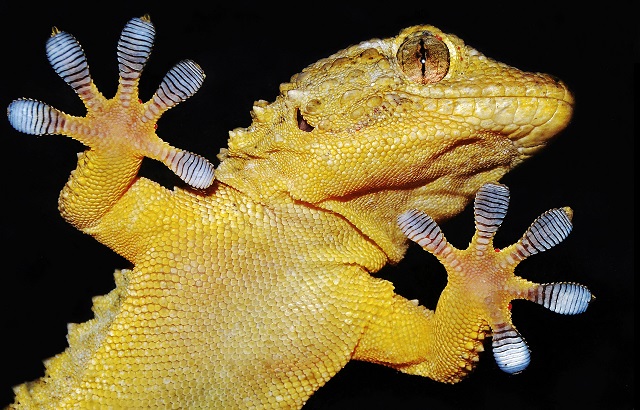
Image source: Shutterstock
Researchers at the Oregon State University (OSU) are studying the adhesion mechanism of geckos, which have a peculiar ability to hold on to any surface, including hanging upside down.
The study has been published in the Journal of Applied Physics. By default, geckos’ feet are non-sticky, but they have the ability to activate their stickiness on and off using the hairs on their toes.
This amazing characteristic helps these lizards to attain a very high speed or even stick to ceilings without spending too much energy. This unique process was described by Alex Greaney, an assistant professor of engineering at OSU and a co-author of this study.
Greaney explained that geckos use van der Waals forces to stick to walls and ceilings. These forces are weak atomistic level forces; however, geckos are able to leverage these forces thanks to an extraordinary system of branched hairs on their toes.
These hairs, also known as 'seta', and their numerous branches undergo deformation to make close contact with even the roughest of surfaces, and as a result, millions of contact points are formed. Each of these contact points, in turn carries a small load. In addition to geckos, spiders and insects also use this adhesion system mechanism.
Understanding the subtleties of the process for switching stickiness on and off is groundbreaking. By using mathematical modeling, we've found a simple, but ingenious, mechanism allows the gecko to switch back and forth between being sticky or not. Geckos' feet are by default nonsticky, and this stickiness is activated through application of a small shear force. Gecko adhesion can be thought of as the opposite of friction.
Alex Greaney - Co-Author and Assistant Professor of Engineering at OSU
The researchers also found that this strong, switchable behavior is extremely subtle and a perfect blend of flexibility, angle and hair extensibility results in outstanding adhesion.
For the past decade, many scientists have been trying to develop synthetic dry-adhesives, which are already being utilized in climbing robots that can participate in search and rescue operations. Greaney went on to say that seta can absorb a considerable amount of energy and can also recover this stored energy.
Such absorption of energy produces a robust adhesive joint. Greaney further added that one potential application of this latest study will be to improve these synthetic adhesives. In the future, the gecko adhesion mechanism can be used for robots operating in extreme environments.
This is another example of where scientists and researchers have taken inspiration from nature to further our understanding and development of technology.
One such example is the study of the silk produced by spiders and trying to find ways of harnessing its strength for structural applications possibly using carbon nanotubes. Another being the recent development of 'origami' robots that can unfold in a similar fashion to the way that linear amino acid sequences fold into complex proteins.